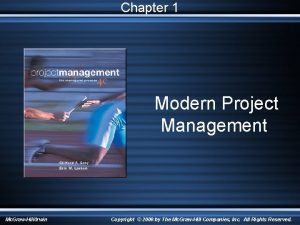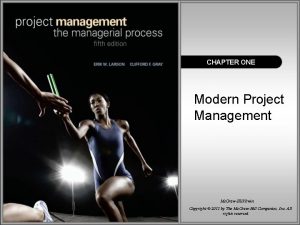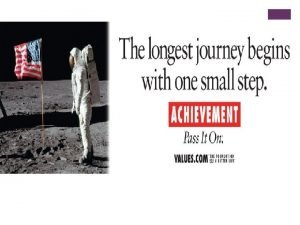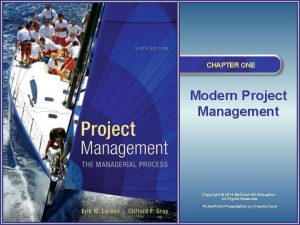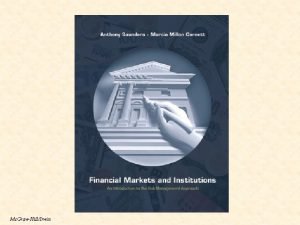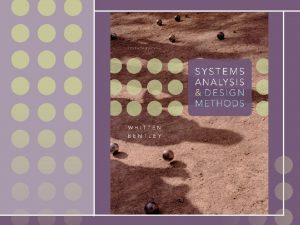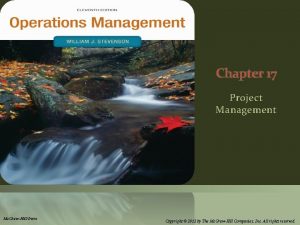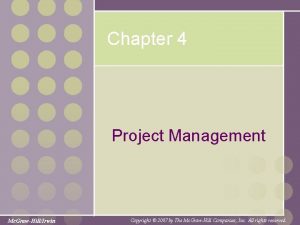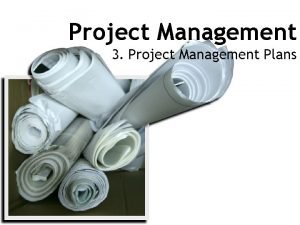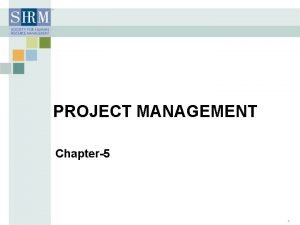CHAPTER ONE Modern Project Management Mc GrawHillIrwin Copyright














- Slides: 14

CHAPTER ONE Modern Project Management Mc. Graw-Hill/Irwin Copyright © 2011 by The Mc. Graw-Hill Companies, Inc. All rights reserved.

What is a Project? • Project Defined – A complex, nonroutine, one-time effort limited by time, budget, resources, and performance specifications designed to meet customer needs. • Major Characteristics of a Project – Has an established objective. – Has a defined life span with a beginning and an end. – Requires across-the-organizational participation. – Involves doing something never been done before. – Has specific time, cost, and performance requirements. 2

Programs versus Projects • Program Defined – A series of coordinated, related, multiple projects that continue over an extended time and are intended to achieve a goal. – A higher level group of projects targeted at a common goal. – Example: • Project: completion of a required course in project management. • Program: completion of all courses required for a business major. 3

Comparison of Routine Work with Projects Routine, Repetitive Work Projects Taking class notes Writing a term paper Daily entering sales receipts into the accounting ledger Setting up a sales kiosk for a professional accounting meeting Responding to a supply-chain request Developing a supply-chain information system Practicing scales on the piano Writing a new piano piece Routine manufacture of an Apple i. Pod Designing an i. Pod that is approximately 2 X 4 inches, interfaces with PC, and stores 10, 000 songs Attaching tags on a manufactured product Wire-tag projects for GE and Wal-Mart TABLE 1. 1 4

Project Life Cycle FIGURE 1. 1 5

The Challenge of Project Management • The Project Manager – Manages temporary, non-repetitive activities and frequently acts independently of the formal organization. • Marshals resources for the project. • Is linked directly to the customer interface. • Provides direction, coordination, and integration to the project team. • Is responsible for performance and success of the project. – Must induce the right people at the right time to address the right issues and make the right decisions. 6

The Importance of Project Management • Factors leading to the increased use of project management: – Compression of the product life cycle – Knowledge explosion – Triple bottom line (planet, people, profit) – Corporate downsizing – Increased customer focus – Small projects represent big problems 7

Benefits of an Integrative Approach to Project Management • Integration (or centralization) of project management provides senior management with: – An overview of all project management activities – A big picture of how organizational resources are used – A risk assessment of their portfolio of projects – A rough metric of the firm’s improvement in managing projects relative to others in the industry – Linkages of senior management with actual project execution management 8

Integrated Project Management Systems • Problems resulting from the use of piecemeal project management systems: – Do not tie together the overall strategies of the firm. – Fail to prioritize selection of projects by their importance of their contribution to the firm. – Are not integrated throughout the project life cycle. – Do not match project planning and controls with organizational culture to make appropriate adjustments in support of project endeavors. 9

Integrated Management of Projects FIGURE 1. 2 10

Major Functions of Portfolio Management • Oversee project selection. • Monitor aggregate resource levels and skills. • Encourage use of best practices. • Balance projects in the portfolio in order to represent a risk level appropriate to the organization. • Improve communication among all stakeholders. • Create a total organization perspective that goes beyond silo thinking. • Improve overall management of projects over time. 11

The Technical and Sociocultural Dimensions of the Project Management Process FIGURE 1. 3 12

An Overview of Project Management 5 e. 13

Key Terms ISO 9000 Program Project life cycle Project Management Professional (PMP) Sociotechnical perspective 14
 Introduction to software project management
Introduction to software project management Modern process transitions in spm
Modern process transitions in spm Modern project management began with what project
Modern project management began with what project Chapter 1 modern project management
Chapter 1 modern project management A series of coordinated related multiple projects
A series of coordinated related multiple projects Trends in project portfolio management
Trends in project portfolio management One god one empire one religion
One god one empire one religion One one one little dogs run
One one one little dogs run One king one law one faith
One king one law one faith One empire one god one emperor
One empire one god one emperor One ford
One ford See one do one teach one
See one do one teach one One price policy
One price policy Twelfth night speeches
Twelfth night speeches See one do one teach one
See one do one teach one




